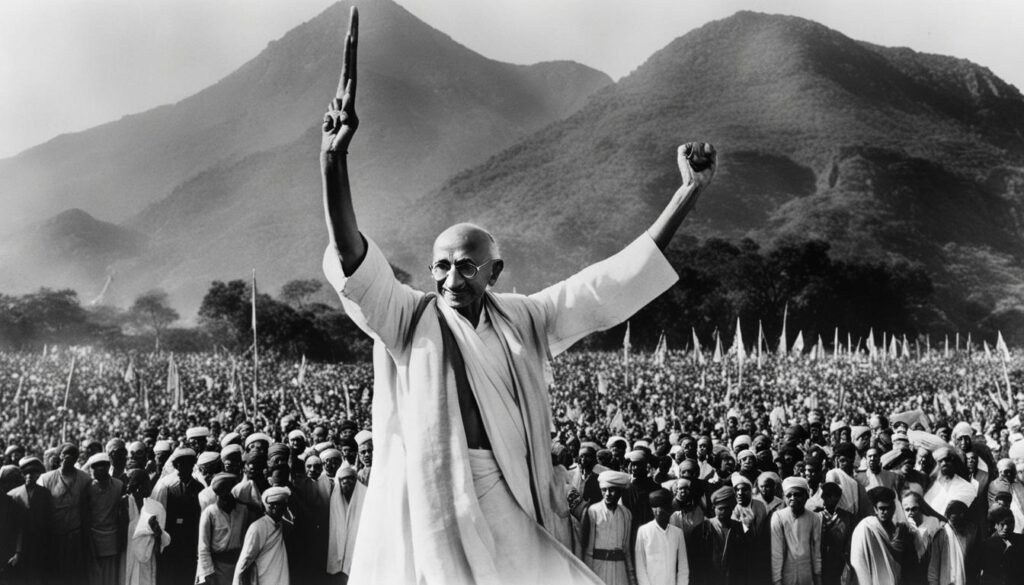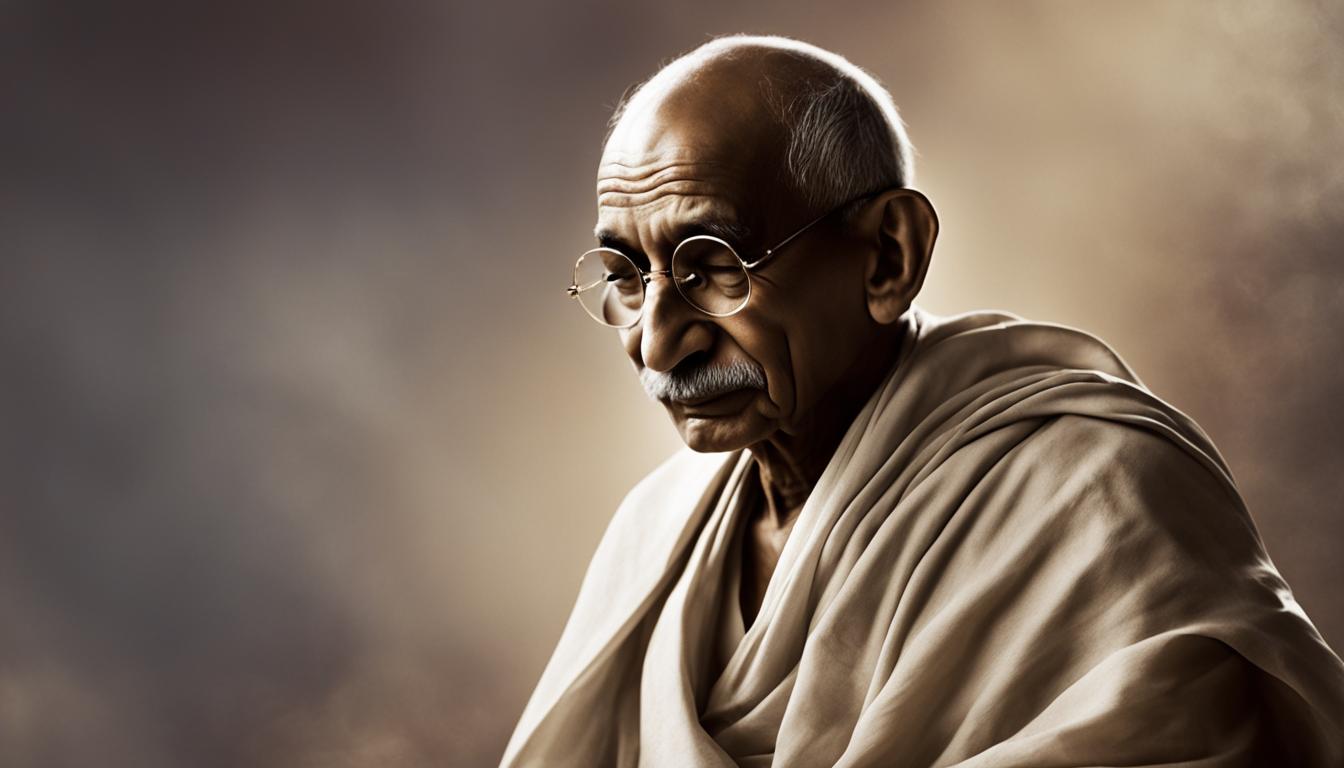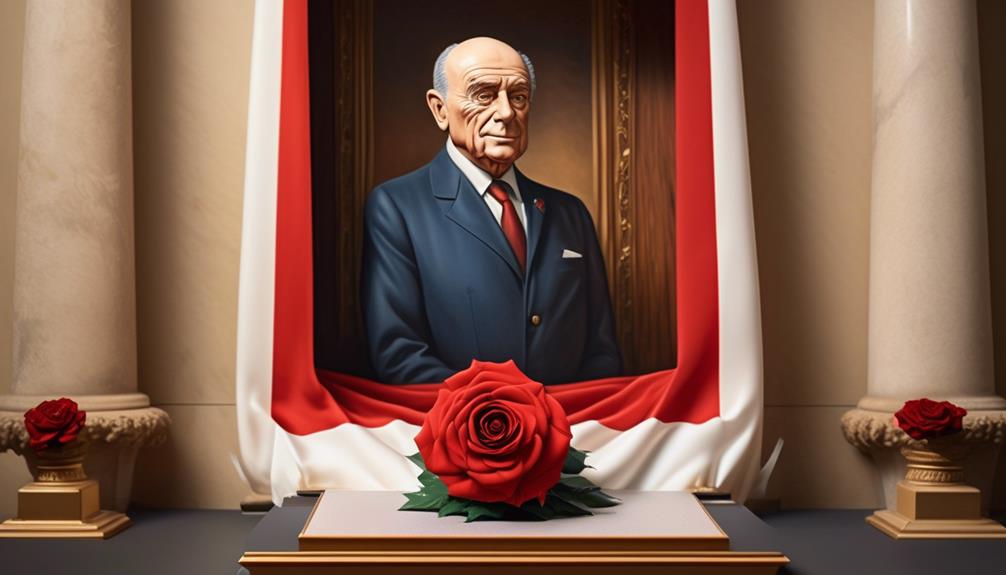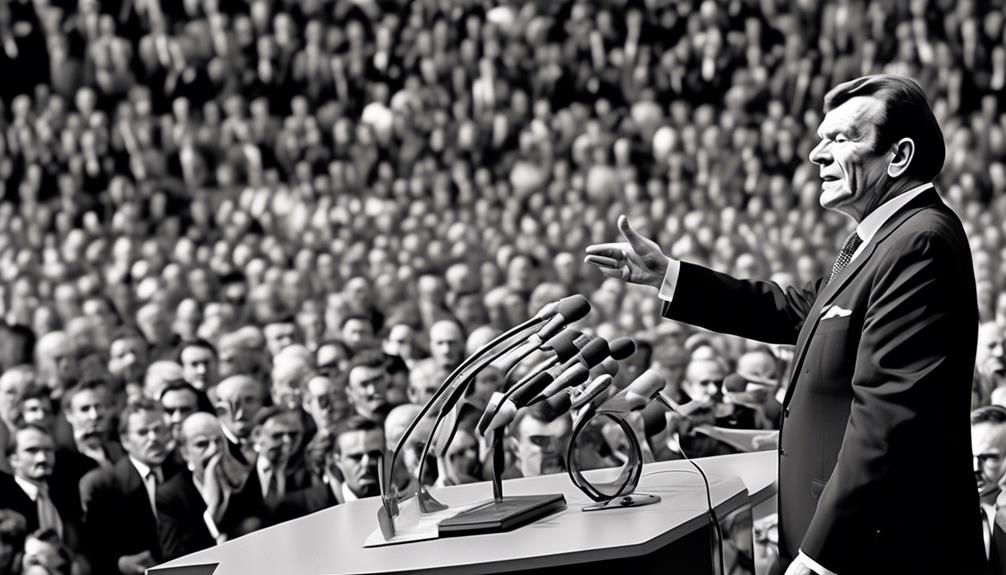Mahatma Gandhi, often revered as the father of India, is honored for his important part in the country’s fight for independence and his advocacy for ideologies like truth and nonviolent resistance. His wisdom continues to inspire and impact us today. Here are some powerful quotes from Mahatma Gandhi that uphold the virtues of peace, nonviolence, and enlightenment, encouraging us to reflect and bring about positive changes in our lives.
Key Takeaways:
- Mahatma Gandhi’s quotations inspire us to embrace peace, nonviolence, and wisdom.
- Reflecting on Gandhi’s words can help us make positive changes in our lives.
- Gandhi’s teachings encourage personal transformation and the pursuit of truth.
- Compassion, service to others, and humility are important values emphasized by Gandhi.
- We can learn from Gandhi’s leadership and activism in the fight against injustice.
The Power of Self-Transformation
Gandhi believed that personal transformation is the key to societal change. He encouraged individuals to examine themselves and strive for continuous learning and growth. Gandhi’s wisdom and inspirational quotes on self-transformation serve as powerful reminders of the importance of self-reflection and the impact we can make through our actions and service to others.
“Live as if you were to die tomorrow. Learn as if you were to live forever.”
This quote by Gandhi highlights the urgency of living life to its fullest and embracing every moment. It encourages us to seize opportunities for growth and learning, continuously expanding our knowledge and wisdom. By approaching life with a sense of curiosity and a thirst for knowledge, we can unlock our full potential and contribute to positive change.
“The best way to find yourself is to lose yourself in the service of others.”
This Gandhi quote underscores the transformative power of serving others. By shifting our focus from ourselves to the needs of others, we not only discover our true purpose but also experience personal growth and fulfillment. Through selfless acts of service, we can make a meaningful difference in the lives of others and contribute to the betterment of society as a whole.
The Importance of Self-Reflection
Gandhi’s emphasis on self-transformation highlights the significance of self-reflection in personal development. By taking the time to introspect and examine our beliefs, values, and behaviors, we can identify areas for improvement and work towards becoming the best version of ourselves.
- Reflect on your actions: Consider how your actions align with your values and the impact they have on others. Are there areas where you can make positive changes or contribute more meaningfully?
- Cultivate a growth mindset: Embrace a mindset of continuous learning and growth, always seeking new knowledge and challenging yourself to expand your horizons.
- Practice gratitude: Cultivate an attitude of gratitude for the blessings in your life, which can help foster a positive mindset and increase self-awareness.
- Set goals and take action: Identify areas for self-improvement and set specific, achievable goals. Take consistent action towards your goals, recognizing that personal transformation is a journey.
By embracing self-reflection and committing to ongoing personal growth, we can embody the ideals of Gandhi and contribute to creating a more compassionate and peaceful world.
Nonviolence as a Path to Change
Gandhi’s philosophy of nonviolence, or ahimsa, is one of his most well-known teachings. He believed that violence only begets more violence and that lasting change can only be achieved through peaceful means. As Gandhi famously said, “An eye for an eye only ends up making the whole world blind.”
Gandhi viewed nonviolence as a weapon of the strong, emphasizing its power to bring about positive transformation. He believed in the potential of peaceful resistance to challenge oppressive systems and foster social progress. In his words, “Nonviolence is a weapon of the strong.”
“An eye for an eye only ends up making the whole world blind.”
– Mahatma Gandhi
“Nonviolence is a weapon of the strong.”
– Mahatma Gandhi
These quotes serve as a poignant reminder that peaceful actions rooted in nonviolence can have a profound impact on society. By choosing nonviolent methods to address injustices, we can strive for lasting change that values the dignity and rights of all individuals.
| Gandhi Quotes on Nonviolence |
|---|
| “An eye for an eye only ends up making the whole world blind.” |
| “Nonviolence is a weapon of the strong.” |
The Importance of Truth and Integrity
Gandhi believed that truth and integrity were essential aspects of personal and societal life. According to him, speaking the truth and living with honesty were crucial for building a just and peaceful world. His leadership quotes and motivational quotes inspire us to be the change we wish to see in the world and highlight the interconnectedness of our thoughts, words, and actions.
“Be the change that you wish to see in the world.”
“Your beliefs become your thoughts, your thoughts become your words, your words become your actions.”
These powerful words by Mahatma Gandhi reinforce the idea that our actions and choices should be aligned with our values. By embracing the importance of truth and integrity, we can contribute to a more harmonious and just society.
| Key Messages | Quotations |
|---|---|
| Importance of honesty | “Satyagraha is firmly grounded in ahimsa, or total nonviolence, which is an active force of the highest order. It is not a negative force, but the highest attribute of the soul.” |
| Building a just society | “There is no god higher than truth.” |
| Alignment of values and actions | “Action expresses priorities.” |
The Power of Forgiveness and Compassion
Forgiveness and compassion were central to Mahatma Gandhi’s teachings. He believed that forgiveness was a sign of strength, and that true peace could only be achieved through understanding and empathy. Gandhi’s inspirational quotes on forgiveness and compassion serve as a powerful reminder of the transformative power of these qualities.
“The weak can never forgive. Forgiveness is the attribute of the strong.”
“The greatness of humanity is not in being human, but in being humane.”
These profound words by Gandhi encourage us to cultivate the strength and compassion within ourselves to embrace forgiveness and treat others with kindness. By letting go of grudges and choosing forgiveness, we demonstrate our capacity for healing and allow peace to prevail.

The Transformative Power of Forgiveness
Forgiveness is often seen as a sign of weakness or surrender. However, Gandhi believed that it required great strength and courage to forgive. When we forgive, we free ourselves from the burden of anger and resentment, and open ourselves to healing and growth. By choosing forgiveness, we break the cycle of negativity and create space for compassion and understanding to flourish.
The Importance of Compassion
Gandhi emphasized the significance of compassion in our interactions with others. By practicing compassion, we acknowledge the humanity in every individual and foster a sense of connection and empathy. Compassion allows us to recognize the shared struggles and experiences that unite us as humans, and encourages us to respond with love and understanding instead of judgment or hostility.
| Benefits of Forgiveness and Compassion |
|---|
|
By embracing forgiveness and compassion in our lives, we contribute to the creation of a more harmonious and peaceful world. Gandhi’s profound teachings continue to inspire us to cultivate these qualities within ourselves and extend them to others, allowing us to play a part in building a more compassionate and forgiving society.
Environmental Consciousness and Simplicity
Gandhi’s philosophy not only encompassed social justice but also emphasized environmental consciousness and the value of simplicity. He believed in living in harmony with nature and practicing a sustainable lifestyle. Gandhi’s influential quotes shed light on his philosophy:
“Earth provides enough to satisfy every man’s needs, but not every man’s greed.”
“To call woman the weaker sex is a libel; it is man’s injustice to woman.”
These quotes highlight Gandhi’s belief in the interconnectedness of human beings and the environment. He recognized that overconsumption and greed can lead to the exploitation of nature and the marginalization of others. By advocating for simplicity, Gandhi encouraged us to reassess our priorities and embrace a more sustainable way of living. Moreover, Gandhi’s commitment to gender equality is evident in his belief that labeling women as weaker is an injustice. His philosophy extends beyond environmental issues and encompasses a holistic approach to creating a just and harmonious world.
Gandhi’s Advocacy for Gender Equality
Gandhi was a firm believer in gender equality and fought against the injustices faced by women. He recognized that true equality could only be achieved when women are empowered and their rights are respected. Gandhi’s quote challenges the societal notion of women being weaker, reinforcing the idea that women are equal to men in strength and ability. This quote resonates with his broader philosophy of justice and equality, addressing not only environmental consciousness and simplicity but also issues of social and gender discrimination.
Overcoming Injustice and Oppression
Gandhi dedicated his life to fighting against injustice and oppression, and his words reflect his commitment to social equality and peace.
“First they ignore you, then they laugh at you, then they fight you, then you win.”
– Mahatma Gandhi
“In a gentle way, you can shake the world.”
– Mahatma Gandhi
These famous Gandhi quotes inspire us to stand up against injustice and work towards a more equitable and peaceful society. They remind us that even in the face of adversity, change is possible through persistent determination and peaceful resistance. Gandhi’s teachings empower us to confront oppression and overcome it with love, compassion, and unwavering commitment to justice.

The Power of Service to Others
Gandhi believed in the transformative power of service to others. He emphasized the importance of using one’s skills and resources to benefit society and make a positive impact.
“The best way to find yourself is to lose yourself in the service of others.”
“Man becomes great exactly in the degree in which he works for the welfare of his fellow-men.”
These quotes remind us of our duty to serve others and contribute to the well-being of our communities.
| Benefits of Service to Others |
|---|
| 1. Personal fulfillment and sense of purpose |
| 2. Development of empathy and compassion |
| 3. Building stronger and more connected communities |
| 4. Making a positive difference in the lives of others |
| 5. Creating a ripple effect of kindness and generosity |
Service to others is not only beneficial for the recipients but also for ourselves. It allows us to discover our true purpose, cultivate empathy, and contribute to the betterment of society.
Through acts of service, we can exemplify the values and teachings of Mahatma Gandhi and inspire others to join us in making a positive impact on the world. Let us embrace the power of service and dedicate ourselves to the welfare of our fellow human beings.
The Strength of Compassionate Leadership
Gandhi was not only a leader in the fight for India’s independence but also a proponent of compassionate leadership. He believed that true strength comes from empathy and understanding, rather than aggression and dominance. Some of his quotes on compassionate leadership include:
“Strength does not come from physical capacity. It comes from an indomitable will.”
“When restraint and courtesy are added to strength, the latter becomes irresistible.”
These quotes inspire us to lead with compassion and empathy, and to prioritize understanding over power. Gandhi’s teachings remind us that true leadership is rooted in kindness and the ability to connect with others on a deep level. By embodying these qualities, we can create a harmonious and compassionate environment where everyone feels valued and supported.

The Power of Empathy
One of the key aspects of compassionate leadership is empathy. Gandhi believed that by putting ourselves in others’ shoes, we can understand their perspectives and needs better. This allows us to make decisions that consider the well-being and aspirations of everyone involved.
Building Strong Relationships
Compassionate leaders prioritize building strong relationships based on trust, respect, and open communication. By fostering a supportive and inclusive environment, they encourage collaboration and teamwork, leading to higher productivity and a positive work culture.
Serving Others
Compassionate leaders also prioritize serving others. Gandhi famously said, “The best way to find yourself is to lose yourself in the service of others.” By taking the time to understand and address the needs of their team members, compassionate leaders can create a sense of purpose and belonging.
Inspiring and Motivating
Compassionate leaders inspire and motivate others to achieve their full potential. Through their words and actions, they encourage growth, provide guidance, and empower their team members to overcome obstacles and succeed.
Leading by Example
Finally, compassionate leaders lead by example. They embody the values they espouse, demonstrating integrity, honesty, and fairness in their interactions. By modeling the behavior they expect from others, they create a culture of trust and accountability.
Compassionate leadership is not only valuable in professional settings but also in personal relationships and communities. By embracing Gandhi’s principles of empathy, service, and leading by example, we can create a more compassionate and harmonious world.
The Importance of Personal Responsibility
Gandhi believed in the power of personal responsibility and the role it plays in creating positive change in the world. He emphasized that every individual has the capacity to make a difference through their choices and actions. By taking responsibility for our own lives, we can contribute to the betterment of society and create a more peaceful and harmonious world.
“The future depends on what you do today.”
“Change yourself – you are in control.”
These powerful quotes by Mahatma Gandhi remind us of our own agency and ability to shape our destinies. They inspire us to take action and be proactive in creating the change we wish to see in the world. Each decision we make and every action we take can have a profound impact on our lives and the lives of others.
By assuming personal responsibility, we empower ourselves to make conscious choices that align with our values and aspirations. Instead of waiting for others to change or for circumstances to improve, we recognize that change begins with us. We have the power to challenge societal norms, break free from limiting beliefs, and create a positive ripple effect in our communities.
When we take ownership of our lives and actions, we become catalysts for peace, compassion, and progress. We understand that our individual contributions, no matter how small, are vital to creating a more peaceful and just world. By embracing personal responsibility, we can inspire others to do the same and collectively work towards a brighter future.
| Key Takeaways |
|---|
| 1. Each individual has the power to make a positive difference in the world. |
| 2. Personal responsibility involves taking ownership of our choices and actions. |
| 3. By embracing personal responsibility, we can contribute to a more peaceful and harmonious society. |
| 4. Our decisions and actions have the potential to inspire others and create a ripple effect of positive change. |
Embracing Diversity and Inclusivity
Gandhi championed the value of diversity and inclusivity in society. He believed that no culture or individual should be excluded or marginalized based on their background or beliefs. Gandhi’s wisdom quotes on diversity and inclusivity serve as a powerful reminder of our responsibility to create inclusive communities that embrace the richness of different cultures and perspectives.
“No culture can live if it attempts to be exclusive.”
“In matters of conscience, the law of the majority has no place.”
These quotes highlight Gandhi’s belief that inclusivity is essential for the well-being and progress of society. By embracing diversity, we can foster understanding, promote equality, and cultivate a more harmonious world.

| Gandhi’s Quotes on Diversity | Meaning |
|---|---|
| “No culture can live if it attempts to be exclusive.” | Exclusivity leads to the stagnation and decline of cultures. Embracing diversity and inclusivity is vital for cultural vitality and progress. |
| “In matters of conscience, the law of the majority has no place.” | Majority rule should not override individual rights and ethical considerations. The true test of a just society lies in how it respects the conscience of every individual. |
Gandhi’s message on diversity and inclusivity echoes through time, inspiring us to celebrate differences and build communities that promote equality, understanding, and compassion.
The Pursuit of Truth and Justice
Gandhi was a staunch advocate of truth and justice, believing that these principles should guide our actions and decisions. He emphasized the importance of standing up against injustice and speaking the truth, even in the face of opposition. As he famously said, “An unjust law is itself a species of violence. Arrest for its breach is more so.” Gandhi believed that it is our responsibility to challenge unfair laws and systems to create a more just society. He also recognized that truth is not determined by popular opinion, stating, “An error does not become truth by reason of multiplied propagation, nor does truth become error because nobody sees it.”
To Gandhi, the pursuit of truth and justice requires unwavering commitment and the courage to question prevailing norms. It is through seeking truth and confronting injustice that we can transform ourselves and our world. As we align our actions with principles of honesty and fairness, we contribute to the collective effort towards a society where justice prevails.
“An unjust law is itself a species of violence. Arrest for its breach is more so.”
“An error does not become truth by reason of multiplied propagation, nor does truth become error because nobody sees it.”
The Power of Truth and Justice
When we prioritize truth and justice in our lives, we become agents of change. By seeking truth, we challenge misinformation and promote understanding. By standing up against injustice, we ensure that marginalized voices are heard and that everyone has equal access to opportunities and resources. Through our actions, we inspire others to join the pursuit of truth and justice, creating a ripple effect of positive transformation.
| Benefits of Prioritizing Truth and Justice | Examples |
|---|---|
| Building trust and credibility | Implementing transparent policies in organizations |
| Promoting equality and fairness | Advocating for legislation that protects the rights of marginalized communities |
| Fostering harmonious relationships | Engaging in open and honest communication with colleagues and loved ones |
| Creating lasting social change | Participating in grassroots movements and advocating for systemic reforms |
By embracing the values of truth and justice, we contribute to the betterment of society and make a positive impact on the lives of others. As Mahatma Gandhi said, “You must be the change you wish to see in the world.” Let us strive to be catalysts for truth and justice, inspiring others to join us in creating a world where everyone can thrive.
The Value of Humility and Continuous Learning
Gandhi’s wisdom extends beyond his advocacy for non-violence and social justice. He recognized the value of humility and continuous learning in personal growth and wisdom. Gandhi believed that acknowledging our own limitations and staying open to constant improvement were essential in our journey towards becoming better individuals. He famously said, “It is unwise to be too sure of one’s own wisdom. It is healthy to be reminded that the strongest might weaken and the wisest might err.” This quote serves as a reminder of the importance of humility and the need to remain humble and receptive to new knowledge and perspectives throughout our lives.
Furthermore, Gandhi understood the significance of humor in maintaining a balanced perspective. In a world filled with challenges and hardships, he recognized the power of laughter and its ability to uplift our spirits. Gandhi remarked, “If I had no sense of humor, I would long ago have committed suicide.” This quote highlights the value of humor as a coping mechanism and the ability to find joy even in the face of adversity. It reminds us of the importance of maintaining a lighthearted approach when navigating through the complexities of life.
By embracing humility and continuously seeking knowledge and personal growth, we can follow in Gandhi’s footsteps and work towards becoming more compassionate, enlightened individuals. The path of humility and continuous learning enables us to develop a deeper understanding of ourselves, others, and the world around us, leading to personal transformation and wisdom.
| Gandhi Quotes on Humility and Continuous Learning |
|---|
| “It is unwise to be too sure of one’s own wisdom. It is healthy to be reminded that the strongest might weaken and the wisest might err.” |
| “If I had no sense of humor, I would long ago have committed suicide.” |

The Indomitable Spirit and Power of Love
Gandhi’s teachings emphasized the power of love and the indomitable spirit of human beings. He believed that love was the strongest force in the world and that it had the power to overcome hatred and violence. Some of his quotes on love and the indomitable spirit include:
“The day the power of love overrules the love of power, the world will know peace.”
“Love is the strongest force the world possesses.”
These quotes inspire us to cultivate love and compassion in our lives and work towards a more peaceful world.
| Quotes | Meaning |
|---|---|
| “The day the power of love overrules the love of power, the world will know peace.” | This quote highlights the transformative power of love and its potential to bring about peace in the world. |
| “Love is the strongest force the world possesses.” | Gandhi emphasizes that love is a powerful force that can overcome any form of violence or hatred. |
Conclusion
Mahatma Gandhi’s quotations continue to inspire and guide us today, reminding us of the importance of personal transformation, nonviolence, truth, compassion, and service to others. His profound wisdom and teachings provide us with valuable insights into how we can live more meaningful and purposeful lives.
By reflecting on Gandhi’s powerful words, we are encouraged to examine our own actions and choices, and strive for positive change within ourselves and in the world around us. His emphasis on nonviolence as a path to change reminds us that peaceful resistance can have a profound impact and bring about lasting transformation.
Gandhi’s teachings on truth and integrity highlight the importance of honesty and authenticity in creating a just and peaceful society. Through his quotes on forgiveness and compassion, he teaches us the power of empathy and understanding in fostering harmonious relationships and resolving conflicts.
Furthermore, Gandhi’s advocacy for environmental consciousness and simplicity serves as a reminder to live in harmony with nature and embrace a sustainable lifestyle. Finally, his inspirational words on leadership, personal responsibility, and the value of diversity and inclusivity inspire us to lead with compassion, take ownership of our actions, and create inclusive communities that celebrate the uniqueness of every individual.
Incorporating these principles into our lives, both individually and collectively, can help us work towards a more peaceful and just society, just as Gandhi envisioned. Let us draw strength and inspiration from his timeless wisdom as we navigate the complexities of our daily lives and continue to strive for a better world.
What Inspired Mahatma Gandhi and Mother Teresa to Share Their Peaceful Messages?
FAQ
Who was Mahatma Gandhi?
Mahatma Gandhi, often referred to as the father of India, was a revered leader in the freedom struggle and a proponent of truth and non-violence.
What were some of Mahatma Gandhi’s teachings?
Mahatma Gandhi’s teachings emphasized self-transformation, nonviolence, truth, compassion, service to others, and the value of diversity and inclusivity.
Why is Mahatma Gandhi considered a symbol of peace and inspiration?
Mahatma Gandhi’s advocacy for peaceful resistance, justice, and equality made him a symbol of peace and inspiration for people worldwide.
What is the significance of Mahatma Gandhi’s philosophy of nonviolence?
Mahatma Gandhi believed that lasting change can only be achieved through peaceful means and nonviolence serves as a powerful tool for positive transformation.
What are some famous quotes by Mahatma Gandhi?
Some famous quotes by Mahatma Gandhi include “Be the change that you wish to see in the world” and “The day the power of love overrules the love of power, the world will know peace.”
How did Mahatma Gandhi champion the value of simplicity and service to others?
Mahatma Gandhi believed in living a simple and sustainable lifestyle, while also emphasizing the importance of using one’s skills and resources to benefit society.
What were Mahatma Gandhi’s beliefs on forgiveness and compassion?
Mahatma Gandhi believed that forgiveness and compassion were signs of strength and essential for achieving true peace and understanding.
How did Mahatma Gandhi advocate for compassionate leadership?
Mahatma Gandhi believed that true strength comes from empathy and understanding, and he emphasized the importance of leading with compassion and restraint.
What was Mahatma Gandhi’s view on personal responsibility?
Mahatma Gandhi believed in the power of personal actions and choices, and he emphasized the importance of taking responsibility for creating positive change.
How did Mahatma Gandhi promote inclusivity and diversity?
Mahatma Gandhi believed that no culture or individual should be marginalized, and he advocated for embracing diversity and creating inclusive communities.
What did Mahatma Gandhi teach about the importance of truth and justice?
Mahatma Gandhi believed that speaking the truth and standing up against injustice were essential for building a just and peaceful society.
How did Mahatma Gandhi value humility and continuous learning?
Mahatma Gandhi believed in acknowledging one’s limitations and continuously learning and growing, and he saw humility as a pathway to personal growth and wisdom.
What did Mahatma Gandhi teach about the power of love and the indomitable spirit of human beings?
Mahatma Gandhi believed that love was the strongest force in the world and that it had the power to overcome hatred and violence.
How can Mahatma Gandhi’s teachings inspire us in our daily lives?
Mahatma Gandhi’s teachings encourage us to reflect on our own lives, make positive changes, and strive for a more peaceful and just society.
What is the legacy of Mahatma Gandhi’s quotations?
Mahatma Gandhi’s quotations continue to inspire and guide us today, reminding us of the importance of personal transformation, nonviolence, truth, compassion, and service to others.
How can we apply Mahatma Gandhi’s teachings in our communities and the world?
We can apply Mahatma Gandhi’s teachings by embodying the values of nonviolence, truth, compassion, service, inclusivity, and taking personal responsibility for creating positive change.
Lauren’s talent in writing is matched by her passion for storytelling. Her love for books and deep understanding of culture and entertainment add a distinct flavor to her work. As our media and press contact, Lauren skillfully bridges the gap between afterQuotes and the broader media landscape, bringing our message to a wider audience.










